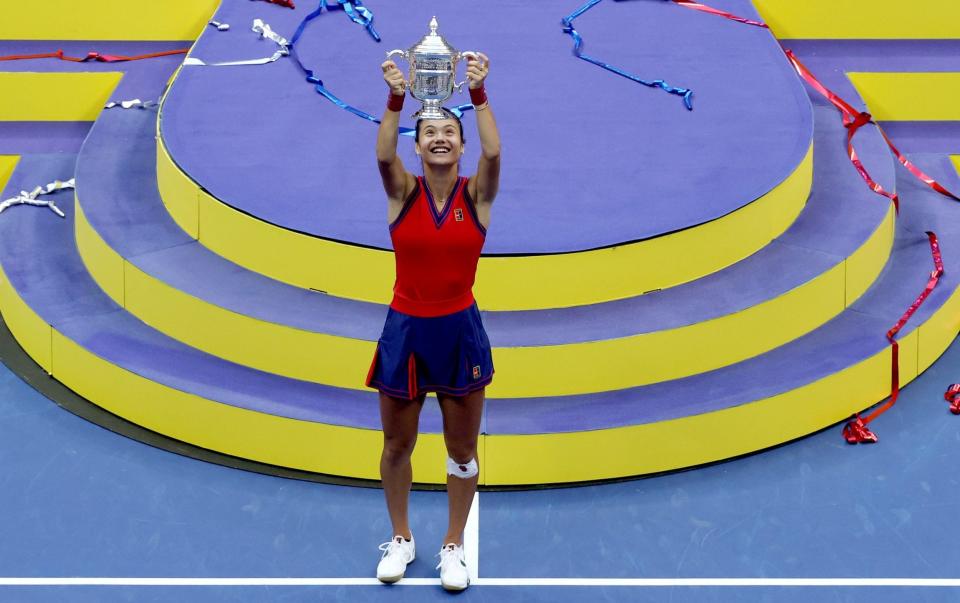Emma Raducanu should emulate the Novak Djokovic model of relentless improvement

“Anything that comes my way, I’m ready to deal with it,” said Emma Raducanu after her nerveless progress through the US Open. But is there anything proactive that she should be doing to work on her game?
When Telegraph Sport asked a couple of coaches where Raducanu might look to improve, we hit as much of a brick wall as her opponents in New York.
Okay, so she doesn’t seem to like hitting overheads. And yes, Martina Navratilova did suggest in these pages recently that Raducanu can still “work on her transition game” and “be more proactive in coming to the net”.
But then Navratilova was herself an unusually enthusiastic volleyer, playing at a time when the women’s game proceeded at a more stately pace.
The modern WTA tour is generally fought out with deep, powerful strikes from the baseline, supplemented by lightning raids forward to pick off easy kills. And those carefully chosen sorties are something Raducanu already does very well.
As for the overheads, most of the women prefer hitting drive volleys in any case – which makes it all the more peculiar that everyone still practises overheads by rote in the pre-match warm-up. Why not practise a shot you are more likely to use?
We also made enquiries about the relatively high number of aborted ball-tosses that Raducanu throws up during matches. But the point there is not so much that her toss is wobbly – because everyone varies slightly on this front – but rather that she has such precise judgement on which tosses not to hit. Most players chase a bad toss and then curse when the ensuing serve fails to find the court.
Indeed, this is one reason why Raducanu’s service stats were so outstanding at the US Open. She maintained an average second serve speed of 82mph throughout the tournament, a big improvement on the field’s average figure of 73mph, while hitting only 17 double-faults in her ten matches.
So how should Raducanu address the next phase of her career? The best model to emulate would be Novak Djokovic, who also arrived with a remarkably well balanced game and struck success early, winning his first major at the age of 20.
There are so many sentences that would apply both to Raducanu and the young Djokovic. He is a lithe athlete and a slick well-balanced mover. Her greatest strength is her return. His backhand is his more natural shot but he has souped up his forehand to become a real weapon. Her slice is a good defensive option which could be used more to change the pace. Neither of them likes an overhead much, and both are very effective in coming forward to kill the point at the net – even if a volley snob like Tim Henman could probably pick holes in their technique if he tried hard enough.
Now 34, Djokovic has evolved into the complete player, whose defeat to Daniil Medvedev on Sunday night had absolutely nothing to do with his game, and everything to do with a combination of mental and physical fatigue. Opposing coaches often throw up their hands, because it is all but impossible to formulate a winning strategy against him.
In a small way, this could be said of Raducanu too. It’s not obvious where to attack her. But then that is partly because the sample sizes are so small. We haven’t seen her go up against a real power merchant yet, like Aryna Sabalenka or an in-form Naomi Osaka. We haven’t seen her play a touch specialist in the class of Ashleigh Barty.
And then there are the even bigger and more significant unknowns, especially the question of how Raducanu will cope with the bizarre, peripatetic lifestyle of a tennis pro. Osaka is clearly struggling with that at the moment, while Bianca Andreescu – who won the US Open at 19 – still has her appetite for the game, but has become frustratingly injury-prone.
Raducanu – again like Djokovic – is a highly analytical and ambitious character. As long as she can avoid these major pitfalls, her game will naturally keep evolving. Time on court is all she needs, as there are no immediate fixes required.

 Yahoo Sport
Yahoo Sport 





































